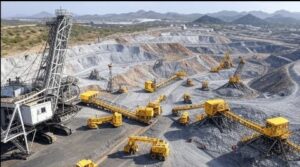HIGHLIGHTS:
Infill and extensional drilling of the East Zone has increased the Oposura Mineral Resource to 3.1 million tonnes @ 5.0% Zn & 2.7% Pb (refer Tables 1 & 2 for details)
East Zone resource tonnage has been increased by 20% at similar zinc, lead & silver grades, indicating potential to increase the mine life of the project
85% of contained metal now classified as Indicated Mineral Resources (up from 75%), representing five years of mine production (refer Scoping Study: ASX: 15 October 2018)
Significant upside for further Mineral Resource expansion; additional drilling is planned
Azure Minerals Limited (ASX: AZS) (“Azure” or “the Company”) is pleased to announce an update to the Mineral Resource estimate (ASX: 4 July 2018) for its 100%-owned Oposura zinc-lead-silver project (“Oposura”) located in Sonora, Mexico.
Successful infill and extensional drilling have increased the East Zone Mineral Resource by 20% and enabled most of the initial East Zone Mineral Resource to now be classified within the JORC Indicated Resource category. The updated total Mineral Resource for Oposura is:
| Table 1: Oposura Mineral Resource Estimate (at a 1.5% Zinc Equivalent Cut-Off Grade) * | |||||
| Tonnes | Grade | ||||
| Mt | Zn (%) | Pb (%) | Zn + Pb (%) | Ag (g/t) | |
| Indicated | 2.5 | 5.3 | 2.9 | 8.2 | 19 |
| Inferred | 0.6 | 3. | 2.1 | 5.6 | 15 |
| TOTAL | 3.1 | 5.0 | 2.7 | 7.7 | 18 |
| Contained Metal | 153,000t | 84,000t | 237,000 | 1,780,000oz | |
* Refer Table 2 for full details of the Mineral Resource and metal equivalence formula Note: Totals may not add exactly due to rounding | |||||
Commenting on the updated Mineral Resource, Azure’s Managing Director, Mr Tony Rovira, said: “Azure is continuing to successfully advance the development and production strategy for Oposura.
“The latest drilling campaign has increased the East Zone resource tonnage and the amount of total contained zinc, lead and silver within the deposit, which will likely lead to an increase in the mine life of the project as part of the Feasibility Study currently in progress.
“Drilling also confirmed that significant quantities of high-grade mineralisation are immediately accessible for open pit and underground mining, supporting near-term mine development.
“Metals prices, particularly zinc, have rebounded strongly since the completion of the Scoping Study and with this strength in the zinc market, Oposura continues to present a strong case for development based upon the existing resources, with significant upside potential to further increase resources.”
MINERAL RESOURCE SUMMARY
This updated Mineral Resource is based upon the Phase 2 program of 58 diamond drill holes totalling 4,567m, in addition to the Phase 1 program of 173 holes totalling 11,109m. The Mineral Resource has been estimated and classified as Indicated and Inferred Mineral Resources in accordance with the guidelines of the JORC Code (2012)1 by CSA Global Pty Ltd (CSA Global), Perth, Western Australia.
Mineral Resources have been reported at a cut-off grade of 1.5% Zinc Equivalent which is considered reasonable for various mining options being assessed in the mining study for the Pre-Feasibility Study (PFS), which is expected to be reported in Q3, 2019.
Significantly, 85% of the contained metal within the Mineral Resource is now classified in the Indicated Mineral Resource category (refer Tables 1 & 2), providing confidence in the continuity of grade and widths of the mineralisation.
The newly increased tonnage of Indicated Resources now represents approximately five years of production based on the Scoping Study throughput rate of 500,000tpa (ASX: 15 October 2018), further supporting and enhancing the results of the Scoping Study which delivered an EBITDA of A$237 million, an NPV of A$112 million, an IRR of 76% and a payback period of 16 months.
The upgraded Mineral Resource also displays significant potential for further expansion upside with mineralisation remaining open in several directions (see Figures 1 & 2). The potential to further increase the project mine life is demonstrated by drill results in the Central Zone, a 500m-wide zone situated between the East and West Zones, where reconnaissance drilling intersected near-surface, high-grade mineralisation, including:
OPDH-173: 12.0m @ 7.7% Zn+Pb from 44.00m; including 4.1m @ 12.5% Zn+Pb
OPDH-178: 9.5m @ 18.9% Zn+Pb from 23.05m; including 6.2m @ 26.6% Zn+Pb
Beneficially, the Phase 2 drilling has confirmed the presence of a continuous zone of very high-grade, zinc-rich mineralisation immediately adjacent to the existing Tunnel D underground mine development (see Figures 3 & 4). This tunnel is in excellent condition allowing Azure to have immediate access to this very rich ore zone and the Company is currently assessing the potential for early development of this high-grade mineralisation.
Two of the better drill intersections in this new Tunnel D high-grade zone include:
OPDH-166: 6.95m @ 38.7% Zn+Pb from 68.15m; including 6.50m @ 41.1% Zn+Pb
OPDH-177: 4.55m @ 36.9% Zn+Pb from 107.55m; including 3.40m @ 48.2% Zn+Pb
Additional drilling is planned to further increase Mineral Resources in the Central Zone, to the north of the deposit and within the wider property.
1 Australasian Code for Reporting of Exploration Results, Mineral Resources and Ore Reserves. The JORC Code, 2012 Edition. Prepared by: The Joint Ore Reserves Committee of The Australasian Institute of Mining and Metallurgy, Australian Institute of Geoscientists and Minerals Council of Australia (JORC).
| Table 2: Mineral Resources for the Oposura Project – Using a 1.5% Zinc Equivalent Cut-Off Grade* | |||||||||||||||||||||
| From the April 2019 Oposura East estimate update and the June 2018 Oposura West estimate | |||||||||||||||||||||
| INDICATED | INFERRED | TOTAL | |||||||||||||||||||
| ZONE | Tonnes | Grade | Contained Metal | Tonnes | Grade | Contained Metal | Tonnes | Grade | Contained Metal | ||||||||||||
| (Mt) | Zn | Pb | Ag | Zn | Pb | Ag | (Mt) | Zn | Pb | Ag | Zn | Pb | Ag | (Mt) | Zn | Pb | Ag | Zn | Pb | Ag | |
| (%) | (%) | (g/t) | (kt) | (kt) | (koz) | (%) | (%) | (g/t) | (kt) | (kt) | (koz) | (%) | (%) | (g/t) | (kt) | (kt) | (koz) | ||||
| EAST | 0.9 | 5.2 | 3.3 | 22 | 47 | 29 | 640 | 0.3 | 3.6 | 2.2 | 16 | 11 | 7 | 150 | 1.2 | 4.8 | 3.0 | 21 | 58 | 800 | |
| WEST | 1.6 | 5.4 | 2.6 | 16 | 86 | 42 | 850 | 0.3 | 3.3 | 2.1 | 14 | 10 | 6 | 140 | 1.9 | 5.0 | 2.6 | 16 | 95 | 49 | 980 |
| TOTAL | 2.5 | 5.3 | 2.9 | 19 | 133 | 72 | 1500 | 0.6 | 3.4 | 2.1 | 15 | 21 | 13 | 290 | 3.1 | 5.0 | 2.7 | 18 | 153 | 84 | 1,780 |
- Assumed commodity prices:
- Assumed concentrate recoveries: Zn 87.5%, Pb 85%, Ag 67% (Locked Cycle Flotation tests: Azure Minerals Ltd, 2018.)
- Assumed Smelter recoveries at: Zn 85%, Pb 95%, Ag 70% (Benchmark Tests: Azure Minerals Ltd, 2018)
- It is the opinion of Azure Minerals Ltd that all the elements included in the calculation have a reasonable potential to be recovered and sold




OPOSURA MINERAL RESOURCE ESTIMATE
The Oposura Mineral Resource estimate (MRE) has been prepared in accordance with the requirements and guidelines of the JORC Code (2012) as detailed in the JORC Code summary tables appended to this report.
Geological Setting
Oposura is hosted by the Cretaceous-age Mesa Formation, a volcano-sedimentary sequence that extends across northern Mexico.
At Oposura, the host lithology is a felsic volcano-sedimentary sequence. Mineralisation predominantly occurs within the Arenillas Formation, a mixed unit of volcanic tuffs and limestone intervals sandwiched between two volcanic welded tuff units. The footwall unit is the Revancha Rhyolite and the hangingwall unit is the Candelaria Formation.
Based on the observed alteration mineralogy, Oposura fits the characteristics of a distal skarn with skarn alteration and sulphide mineralisation replacing limestone horizons within the Arenillas Formation.
Mineralisation comprises zinc, lead and silver-bearing sulphides and iron sulphides (pyrite) occurring as massive to semi-massive stratabound lenses that replace limestone horizons in the sedimentary sequence. Higher grade zinc and lead mineralisation is correlated with elevated silver concentrations. The most extensive mineralised horizon replaces a well-developed, clean, massive to laminated limestone unit near the base of the Arenillas Formation. Extensive skarn alteration of limestone and of calcareous volcaniclastic sedimentary rocks is associated with the sulphide mineralisation and is characterised by manganese-rich calc-silicate minerals with strong, late-stage retrogression.
Massive sulphide mineralisation commences at surface with limited weathering or oxidation.
Dimensions and Geometry
The mineralised horizon crops out discontinuously over approximately two kilometres on the eastern, southern and western slopes of the Oposura mountain (see Figures 3 & 4) and displays sub-horizontal to shallow dips (see Figure 4). Mineral Resource definition drilling defined two separate mineralised zones – East Zone and West Zone, which are separated by the sparsely drilled, 500m-wide Central Zone.
The sub-horizontal dip of the mineralised zones results in vertical thickness being very similar to true thickness. The vertical thicknesses of individual sulphide mineralisation lenses average 7m in East Zone and 3m in West Zone, with maximum vertical thicknesses of 20m in East Zone and 10m in West Zone. The mineralised zones demonstrate good internal continuity of zinc, lead and silver grades appropriate to the Mineral Resource classifications.
Drilling confirmed that the zinc, lead and silver mineralisation within East Zone extends for approximately 470m (north-south) and 325m (east-west) along the eastern slope of the Oposura mountain. Drilling confirmed that the zinc, lead and silver mineralisation within West Zone extends for approximately 400m (north-south) and 475m (east-west) along the southern and western slopes at the western end of the Oposura mountain.
These two Mineral Resource zones are separated by the 500m-wide Central Zone, which has been lightly tested by drilling undertaken by Anaconda and Peñoles during the 1960s and 1970s and Azure in 2018. Several drill holes intersected wide zones of near-surface, high-grade zinc and lead sulphide mineralisation within the Arenillas Formation and the Company considers that there is good potential for the Mineral Resource to be expanded in this area, possibly joining the East, Central and West Zones into a single continuous deposit.
Sampling Details
Mineral Resource definition drilling has been undertaken in two phases. Phase 1 was undertaken in 2017/18 and comprised 173 diamond drill holes for 11,109m of drilling, with 16 holes drilled by the previous owner Puma (983m) and 157 holes by Azure (10,126m). Phase 2 was undertaken in 2018 and comprised 58 diamond drill holes totalling 4,567m, all drilled by Azure. Hole depths ranged from 10m to 134m, with an average depth of 68m, highlighting the shallow nature of the deposit.
Holes were drilled with a variety of azimuths and dips to ensure the mineralised horizon was intersected on an initial 50m × 50m spacing. Additional drilling to infill the hole spacing to 25m x 25m was undertaken in some areas. For the Mineral Resource, all Puma holes and 187 Azure holes (out of a total of 215) intersected mineralisation.
Drill core was sawn in half along the core axis using a wet diamond core saw. All samples were collected from the same side of the core. Duplicate, standard and blank check samples were anonymously submitted with drill core samples at the rate of approximately one standard, blank or duplicate in every 10 samples. When a duplicate sample was required, the ½-core sub-sample was then wet-cut preparing two ¼-core sub-samples for laboratory dispatch, one considered to be the primary sample, the other a duplicate.
Sample lengths for assay purposes were guided by changes in geology and varied from 0.05m to 3.05m, with an average sample mass of 2.75kg.
Sample Preparation and Assaying
Bureau Veritas Mineral Laboratories (BVL) prepared all the samples from Oposura at their sample preparation facilities in Hermosillo, Sonora, Mexico. Samples were weighed, assigned a unique bar code and logged into the laboratory tracking system. Samples were then dried and each sample was crushed to >70% passing a 2mm screen. A 250g sub-sample was collected for pulverising by ring and puck to >85% passing sub 75µm. The 250g sample pulps were then dispatched via courier to BVL in Vancouver, Canada for analysis.
Samples drilled by Puma were analysed by the technique MA200 with 0.25g samples subject to a fouracid digest followed by multi-element ICP-MS analysis producing results for silver and base metals. This technique is considered a total digest for all relevant minerals and has a very low detection limit.
The analytical technique, MA300, was used for all samples drilled by Azure, comprising 0.25g samples subject to a four-acid digest followed by multi-element ICP-ES analysis producing results for silver and base metals. This technique is considered a total digest for all relevant minerals.
Over-limit assays for both Azure and Puma drill samples were re-analysed by:
Method MA370 (0.5g samples digested by 4 acids and analysed by ICP-ES for base metals grading >1%);
Method GC816 (by Classical Titration for zinc grading >20%);
Method GC817 (by Classical Titration for lead grading >10%);
Method FA530 (by fire assay with gravimetric finish for silver grading >200ppm).
Density
Azure collected a total of 1,217 density measurements from drill core samples with 835 samples sourced from within the boundaries of the Mineral Resource and the remainder collected from within lower-grade and waste zones to provide a good range of material for density determinations.
Each sample was dried and measured for length and diameter. The diameter was measured with callipers at three points along the length of the core sample and averaged. The volume of the core sample was calculated and the sample was weighed. Azure calculated the density for the core samples by dividing the dry weight of the sample by its volume.
A total of 196 of the 1,217 samples were sent to Bureau Veritas Laboratories in Hermosillo, Mexico for confirmatory density measurements by immersion of waxed core (method SPG03). The results of the immersion method were compared to densities calculated by Azure. There was no discernible difference between the calliper and immersion methods.
A multivariate regression formula from dry bulk density determinations to Zn% and Pb% was developed for use across the deposit for areas of varying zinc and lead grades. This formula combined the measured density of samples that were subsequently sent for assay.
The multivariate regression formula was also used to analyse the results of the dense media separation testwork.
Metallurgical Test Results
Metallurgical testwork on Oposura mineralisation was conducted at Blue Coast Research (BCR) laboratories in Vancouver, Canada. Metallurgical testwork comprised Dense Media Separation, staged and locked cycle flotation tests, and physical property tests.
Dense Media Separation (DMS) testwork
In several parts of the Oposura mineralised system, thick mineralised intersections comprise narrow bands of very high-grade mineralisation separated by intervals of lower grade or waste material. Azure’s studies indicate that some of these thick mineralised zones may be more suitable to a “bulk” mining approach rather than “selective” mining, thereby reducing unit operating costs and maximising resource recovery.
Testwork was undertaken to assess the suitability of DMS technology to upgrade the grade of the “bulk” mined material by rejecting low grade and waste material while retaining the mineralised material, ahead of entering the milling circuit. DMS is most effective in upgrading ore when there are distinct density differences between mineralised material and waste rock, and this is the case at Oposura.
DMS testwork was initially conducted on rock samples taken from historical underground mine workings. DMS testwork was then extended to include tests on individual drill hole intersections of varying combined zinc and lead grades and zinc to lead grade ratios. These tests were used to ascertain the density at which the DMS circuit could optimise ore recovery and waste rejection.
Follow-up DMS testwork was then conducted on a bulk master sample averaging 6.4% Zn, 4.2% Pb and 28.8g/t Ag that was prepared from the drill core of eleven Mineral Resource drill holes. This testwork showed that an upgrade in both zinc and lead grades of 34% could be achieved with an overall metal recovery of 95%, while rejecting waste material amounting to approximately 30% of the mass entering the DMS circuit.
The positive results achieved from this metallurgical testwork demonstrate that crushing, screening and DMS processing prior to a standard sulphide flotation treatment support the option of utilising DMS technology at Oposura.
Flotation testwork
Staged flotation testwork was conducted on individual drill hole intersections of varying combined zinc and lead grades and zinc to lead grade ratios.
Follow-up staged and locked cycle flotation tests were then conducted on the bulk master composite comprising intersections from several drill holes across the Mineral Resource. The laboratory split the bulk master composite into several sub-samples to allow multiple batch and locked cycle flotation tests to be undertaken.
The staged flotation tests conducted on the bulk master composite were used to optimise primary and secondary grind sizes, flotation times and reagent regimes for the separate zinc and lead concentrates. A locked cycle test was then conducted on the bulk master composite to more closely simulate a continuously operating flotation circuit.
The result of the locked cycle test was a zinc concentrate grading 57.2% Zn with a zinc recovery of 85.6% and a lead concentrate grading 61.4% Pb at a lead recovery of 84.0%. Silver recovery to the lead concentrate was 67.1% Ag at a concentrate grade of 323.8 g/t Ag (10.4 oz/t Ag).
Both the zinc and the lead concentrate grades achieved in the locked cycle test were above the typical industry benchmark grades quoted respectively for zinc and lead concentrates of 53% zinc and 60% lead. A regression line from the batch locked cycle test results back to the benchmark concentrate grades was calculated to interpolate the zinc and lead recoveries. A zinc recovery of 87.5% was interpolated at the benchmark concentrate grade of 53% zinc and a lead recovery of 85% was interpolated at the benchmark concentrate grade of 60% lead.
Multi-element assays were conducted on the separate zinc and lead concentrates produced from the locked cycle test conducted on the bulk master composite. These assays indicated that deleterious elements were not present at levels that would cause concern or penalties from smelters.
The testwork successfully demonstrated that clean, commercial grade concentrates could be produced at high metallurgical recoveries and thereby has eliminated a potential major project risk.
Physical Properties Testwork
Physical properties testwork comprised the establishment of crushing, grinding and abrasion indices. The crusher and ball mill work indices are a measure of the amount of power required respectively to crush and grind mineralisation and are quoted in kilowatt hours per tonne (kWhr/t). The higher the number, the more power that is required to crush and grind the mineralisation prior to flotation.
The abrasion index is a measure of weight loss of metal when in contact with mineralisation. It is used to select materials for items such as mill liners and chutes and to determine how often these items need to be replaced based on wear rates. All three of the indices are within the typical range of expected values for mining projects, and power requirements and wear rates are not expected to be out of the ordinary.
Mining
The overall geometry of East Zone and West Zone Mineral Resources is favourable for potential extraction using a combination of conventional open pit and underground mining techniques. This geometry also allows the resources to be easily accessed from surface, providing exceptional mine scheduling flexibility.
East Zone and West Zone resources crop out at surface in both zones. The extremities of both resource zones could be accessed by a maximum of 200m (East Zone) and 250m (West Zone) of lateral underground mine development. This mine development could be undertaken within mineralisation due to the overall shallow dipping nature of the mineralised horizon. Mining could be undertaken contemporaneously by open pit and underground methods in both the East Zone and West Zone.
The Mineral Resources include distinct areas of higher grade mineralisation that could be scheduled to suit economic circumstances and/or product marketing options.
The Oposura hillslopes at approximately 20 to 25 degrees in the vicinity of East Zone and at approximately 30 to 40 degrees in the vicinity of West Zone. Near surface mineralisation would be amenable to open pit techniques in both East and West Zones. Fresh rock commences at or very close to surface. An historical small-scale open pit was mined at the East Zone. Surveys undertaken in 2017 show this open pit to be approximately 30m in length, with a bench height of approximately 12m and a pit wall angle of approximately 60 degrees.
The maximum depths below surface of the Mineral Resources are approximately 120m (East Zone) and 140m (West Zone). Maximum vertical capital development for ventilation and emergency egress would be limited to these depths. The in-situ rock stress is expected to be low corresponding to the shallow depth of the resources below surface. An historical underground level drive, Tunnel D, in East Zone has a maximum depth below surface of approximately 100 metres. The backs and walls of this level drive are in good condition and have limited ground support.
Historical development drives and room and pillar stopes remain intact and accessible. These stopes were surveyed in 2017 using digital laser techniques. The extraction ratio of the historical room and pillar stopes was measured to be 95%. A room and pillar underground mining method is considered appropriate due to the geometry of the resources.
The sub-horizontal dip of the mineralised zones results in vertical thickness being very similar to true thickness. The vertical thicknesses of individual sulphide mineralisation lenses average 7m in East Zone and 3m in West Zone, with maximum vertical thicknesses of 20m in East Zone and 10m in West Zone. These thicknesses would make both resource zones amenable to modern mechanised open pit and underground mining techniques.
The historical workings are located at or below the lowest resource elevation and show no signs of groundwater ingress. Groundwater ingress is not expected to adversely affect potential mining development or stoping.
Infrastructure
The Oposura project area is located approximately 150km from the capital of the state of Sonora, Hermosillo (population of approximately one million) and is accessed from Hermosillo via a two-lane bitumen highway (National Highway 14).
The nearest bulk commodity export facility is located at the Port of Guaymas. Guaymas is located approximately 330km by road via Hermosillo from the Oposura project. A four-lane concrete highway (National Highway 15) exists between Hermosillo and the Port of Guaymas. Bulk mineral concentrates are currently exported through the Port of Guaymas by several mining companies including Grupo Mexico, BHP Billiton and Freeport McMoran.
A power supply option study undertaken in 2018 showed that power for the project could be obtained from either 230kV or 32kV high voltage transmission lines that pass within 10 kilometres of the project.
Wireless voice and high-speed data communication currently exists at the project site via line of sight to a communications tower located in the nearby town of Moctezuma (population 5,000).
Hydrological studies completed in 2018 identified potential aquifers within the mining concessions. Two bores located on a privately-owned ranch in the Moctezuma river valley were pumped tested as part of the study. Based on the pump test results, the average flow from each of these bores is approximately one million cubic metres (tonnes) of water per annum, which is considered sufficient for a project corresponding to the scale of the Mineral Resources.
Surface rights agreements are in place with the owners of the two private ranches that cover the project area and mineral concessions. The surface rights agreement areas are expected to be sufficient for locating access roads, infrastructure, mining works, process plant and tailings facility required for a project corresponding to the scale of the Mineral Resources.
Environment
The project area is covered by two privately-owned cattle ranches and surface access rights agreements are in place with both owners.
The previous owners of the Oposura project, Puma, applied for and received environmental approval for the clearance of a surface area of up to 5 hectares for the development of a small-scale mine, process plant and tailings facility for Oposura. This environmental approval has been transferred from Puma to Minera Piedra Azul SA de CV (a wholly-owned subsidiary of Azure).
Environmental surveys and studies over the Oposura project area were independently conducted in 2017 and 2018. These surveys indicate that there are no flora or fauna impediments to potential development of the project.
Geological Estimation Domains
For Mineral Resource estimation control, five mineralisation domains and five low-grade halo (nonMineral Resource) domains were identified for East Zone, while for West Zone five mineralisation and five low-grade halo (non-Mineral Resource) domains were grouped into two statistical domains based on statistical and geometric similarities. The domains were identified by geological and spatial continuity, as grade-boundary analysis of zinc, lead and combined zinc + lead showed continuous distributions. The volumes of the domains were modelled using conventional sectional interpretation followed by digital wireframing methods. The wireframe models were reviewed and accepted by Azure and then used to code a digital block model as follows:
Mineralisation: defined using a combined nominal ≥ 1.5% Zn%+Pb% grade cut-off.
Low grade halos (not reportable as Mineral Resources): defined as being any coherent zones enveloping the mineralisation wireframes below the mineralisation modelling cut-off. This allows a more robust measure of dilution around the mineralisation for mine studies.
Sub-blocks were included in the block model to closely match the estimation domain boundaries and the topographic surface and provide adequate resolution on volumes.
Domains were estimated using composites from each estimation domain. For East Zone, the semivariogram models from the same domain were used, for West Zone, the semi-variogram model from the statistical domain grouping was used.
Estimation and Validation Methodology
Quantitative Kriging Neighbourhood Analysis was undertaken using SupervisorTM V8.8 software to assess the effect of changing key Kriging neighbourhood parameters on block grade estimates. Kriging Efficiency and Slope of Regression were reviewed for a range of block sizes, minimum and maximum samples, search dimensions and discretisation grids.
Ordinary Kriging (OK) was adopted to interpolate grades into cells for the mineralised domains and lowgrade halo domains around the mineralisation, inside which the composites for the high-grade domain were removed.
The block size appropriately reflects the dual open-pit and underground scenarios, and the drill hole spacing, which varies from 25m – 50m sections along strike. Intra-section pierce points are evenly spaced in predominance and vary from 10m – 25m in the eastern parts of East Zone, to 40m – 60m in other parts of East Zone and West Zone.
The estimate employed a four-pass search strategy to improve the local grade estimate. The first pass was equal to 2/3 the range of the largest variogram model structure for each variable in each domain, honouring the anisotropic ratios orthogonally. The second pass equated to 100% of the ranges, the third 150% and the fourth 200%. Following the fourth estimation pass, the Sichel mean of the composite within the statistical domain was assigned for Zn%, Pb% and Ag g/t for each domain. The mean was assigned for blocks with unestimated sulphur grades.
All geological modelling and grade estimation was undertaken using SurpacTM V6.6 software.
Reporting Cut-off Grade
The Mineral Resources were reporting above a 1.5% zinc equivalent (ZnEq) grade based upon benchmark Mexican mining and processing costs for the proposed scale of operations, current metallurgical testwork, international benchmark smelting and refining charges, and metal pricing as at the end of May, 2018.
More details are given in the JORC Table 1 Section 3 appended to this ASX release.
Capping was applied to reduce the spatial influence of extremely high-grade samples and the cap values based on outliers from the histogram and probability plots. The 1.0m estimation composite grades were capped to the following maximum values prior to block grade estimation:
| Deposit | Material | Domain | Zn top-cut (%) | Pb top-cut (%) | Ag cut (g/t) |
| Oposura East | Mineralisation | 1 | 25 | 17 | 120 |
| 2 | 29.5 | 16 | 110 | ||
| 3 | 35 | 18 | 320 | ||
| 4 | 35 | 12 | 290 | ||
| 5 | 14 | Uncut | Uncut | ||
| Low-grade halo | 1 | 1.6 | 0.8 | 18 | |
| 2 | 1.5 | 1.5 | 15 | ||
| 3 | 1.1 | 1.5 | 5.6 | ||
| 4 | 1.1 | 1.8 | 10 | ||
| 5 | 1.1 | 1.8 | 10 | ||
| Oposura West | Mineralisation | 1,2,3 | 25 | 17 | 160 |
| 4,5 | 10 | 9 | 60 | ||
| Low-grade halo | 101,102,103 | 2 | 0.8 | 16 | |
| 104,105 | 0.9 | 0.7 | 7 |
Criteria used for Classification
The Mineral Resource has been classified based on the guidelines specified in The JORC Code. The classification level is based upon an assessment of geological understanding of the deposit, geological and mineralisation continuity, drill hole spacing, sampling and assaying processes, QC results, search and interpolation parameters, and an analysis of available density information.
The following approach was adopted:
Consider the classification of Indicated Mineral Resources for large zones of contiguous blocks where consistent, coherent zones:
Average drill spacing nominally 25m in East Zone and no more than 50m in West Zone
Estimation was undertaken in search passes 1 and 2
Number of samples was near the optimum of seven
Slope of regression > 0.5.
Reasons for the classification are:
Geological continuity and confidence in the geological model are high.
Domains one through four of East Zone are drilled at a nominal hole spacing of 25m to 35m. The drill-hole spacing and the estimation quality indicators for these domains are clearly higher than for domain five, therefore the classifications reflect these observations.
Adequate drill coverage has reduced uncertainty in both grade and thickness, despite thickening and higher-grades close to fault zones being evident, particularly in East Zone.
Fault thickening was less evident for West Zone, therefore the assessment of geological continuity for classification was simpler.
Modifying Factor Assumptions
In terms of key modifying factors, it has been assumed that the deposit could be exploited by conventional truck and shovel open pit mining and by conventional mechanised underground room and pillar mining, with ore processed by conventional flotation processes after crushing, dense media separation and milling and with the metallurgical recoveries indicated by preliminary metallurgical test results. Using these assumptions and current commodity prices for zinc, lead and silver, a block reporting cut-off grade of 1.5% Zinc Equivalent was selected as a reasonable basis for reporting the Mineral Resource.
Given the long history of mining in the Sonora region of Mexico, and that there is a current environmental approval in place for a small-scale mining and processing operation at Oposura, the Company believes there are reasonable expectations that a mine and processing operation corresponding to the scale of the Mineral Resource could be developed should (or when) future studies result in the definition of an Ore Reserve.
BACKGROUND
The Mineral Resource estimate for the East and West Zones of the Oposura deposit is located wholly within the Oposura project area which comprises 10 mineral concessions. These concessions are 100% owned by a Mexican entity named Minera Piedra Azul SA de CV (MPA), which is a wholly-owned subsidiary of Azure Minerals Limited (Azure).
On 11 August 2017, MPA executed an agreement with Grupo Minero Puma SA de CV (Puma) whereby MPA agreed to acquire 100% ownership of the Oposura concessions by paying Puma US$1,500,000 and with Puma retaining a residual Net Smelter Return royalty (NSR) of 2.5%.
MPA has paid to Puma the US$1,500,000 in consideration for the acquisition of the Oposura Project and has entered into a royalty agreement with Puma covering Puma’s retained 2.5% NSR royalty. Azure has a 100% legal and beneficial interest in the Oposura project.
-ENDS-
For further information, please contact:
Competent Person Statement:
Information in this document that relates to Sampling Techniques and Data, and Reporting of Exploration Results (sections 1 and 2 of Table 1 of the JORC Code) for the Oposura East and West Mineral Resource estimates is based on information compiled by Dr Neal Reynolds, who is a Member of the Australian Institute of Geoscientists. Dr Reynolds is employed as a Principal Geologist and Director and is a full-time employee of CSA Global Pty Ltd. Mr Alex Whishaw, Senior Resource Geologist at CSA Global in Perth, Western Australia has prepared the Mineral Resource estimate under the direct supervision of Dr Matthew Cobb. Dr Cobb is a Principal Resource Geologist at CSA Global in Perth, Western Australia, and qualifies as an MRE Competent Person, as defined under the JORC Code.
Information in this document that relates to Estimation and Reporting of Mineral Resources (section 3 of Table 1 of the JORC Code) for the Oposura East and West Mineral Resource estimates is based on information compiled by Dr Matthew Cobb, who is a Member of both the Australian Institute of Geoscientists and the Australasian Institute of Mining and Metallurgy. Dr Cobb is employed as a Principal Geologist and is a full-time employee of CSA Global.
Dr Reynolds and Dr Cobb have sufficient experience which is relevant to the style of mineralisation and type of deposit under consideration and to the activity being undertaken to qualify as Competent Persons as defined in the 2012 Edition of the ‘Australasian Code for Reporting of Exploration Results, Mineral Resources and Ore Reserves’.
Dr Reynolds and Dr Cobb consent to the inclusion in the report of the matters based on their information in the form and context in which it appears.
Original Article: https://azureminerals.com.au/wp-content/uploads/2019/05/190508.pdf

















